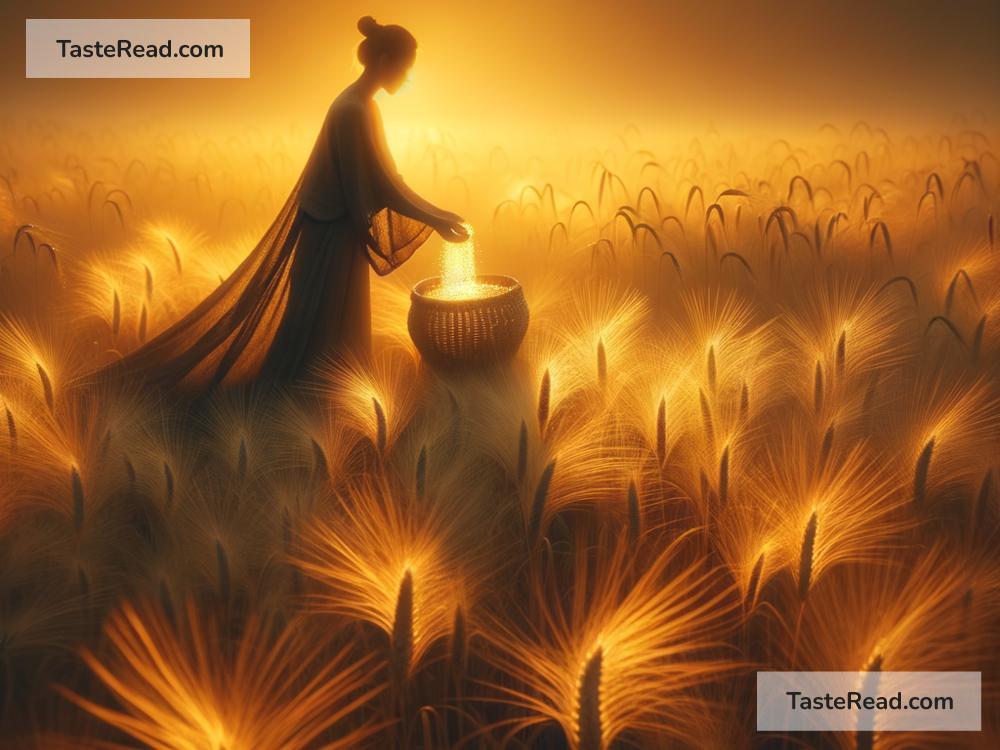The Mythical Tale of the Golden Grain
Throughout history, cultures around the world have created stories that explain mysteries, teach lessons, or offer hope in hard times. One such tale is the mythical story of the Golden Grain, a magical crop said to bring prosperity, peace, and joy to those who cultivate it. Though the golden grain is only a myth, the story has been passed down through generations in many parts of the world, particularly in agricultural societies. Let’s explore this enchanting tale in simple terms.
The Beginning of the Golden Grain
The story begins long, long ago, when the world was still young. People struggled to survive because crops would often fail due to harsh weather, pest infestations, and unfertile soil. The villages were small, and hunger was a problem for everyone. Famine caused sadness to spread, and families grew weaker with each passing season.
Legend has it that one day, a wise and kind goddess known as Alora descended from the heavens. She was said to be the protector of farmers and the bringer of life to the earth. Alora watched as the villagers worked hard but were unable to gather enough food for their families. Moved by their efforts and suffering, she decided to gift humanity something extraordinary—a seed unlike any other.
This seed, according to the myth, sparkled like gold and was said to hold magical powers. Alora told the villagers that the seed would grow into golden grain, a crop that could survive drought, resist pests, and flourish even in the poorest soil. It would provide more nourishment than any other crop, and its beauty would inspire hope. However, her gift came with an important condition: the golden grain would only grow in the soil of unity, care, and respect.
The Test of Unity
At first, the villagers were thrilled with Alora’s gift. They thought their days of hunger were over. However, the goddess’s warning about the “soil of unity” puzzled them. What did she mean by unity? They figured it would be easy to plant the seed, and they started preparing the land.
But as they worked together in the fields, disagreements began to arise. Some wanted to plant the seed immediately, while others insisted on waiting for the perfect weather conditions. Others argued over who would own the grain once it grew. Soon, jealousy and greed crept in, and the villagers stopped working as a team. They tried planting the golden seed separately, each person hoping that their own crop would flourish.
Days turned into weeks, but to everyone’s surprise, the seed would not sprout. The villagers grew frustrated, and some even accused Alora of giving them a useless gift. They complained and argued even more, only deepening their division.
A Stranger’s Wisdom
One day, an old wanderer arrived in the village, carrying a walking stick and wearing a simple cloak. He had heard about the golden seed and the villagers’ struggles. Listening to their complaints, he smiled and said, “The seed will only grow when you learn to work as one. Alora did not lie; you are simply planting it in the wrong soil.”
The villagers were confused. “We have rich soil,” they said. “It’s the best farmland in the area. How could it be the wrong soil?”
The wanderer explained patiently, “The goddess did not mean physical soil. She meant the soil of your hearts—the soil of unity. Only when you work together, support one another, and see beyond your greed will the seed take root.”
Realizing they had misunderstood Alora’s message, the villagers were humbled. They decided to put aside their differences and come together as a community. They shared tools, helped each other prepare the land, and treated one another with kindness and respect. Finally, united as one, they planted the golden seed.
The Miracle and the Lesson
To their amazement, the golden grain began to grow almost immediately. Its stalks shimmered in the sunlight, and its golden color seemed to radiate warmth and joy. The grain grew tall and strong, producing an abundant harvest that could feed every family in the village. The villagers celebrated together, thankful for the lesson they had learned.
From then on, they continued to nurture the soil of unity in their village. Whenever disagreements arose, they reminded themselves of the golden grain and the importance of working together. The golden crop kept flourishing year after year, bringing prosperity not only to their village but also to neighboring communities.
As the tale goes, Alora watched from the heavens and smiled, knowing her gift had taught the villagers more than just how to grow food. It had taught them the power of unity, kindness, and collective effort.
The Message of the Golden Grain
The mythical tale of the golden grain is more than just a story about agriculture—it is a lesson about human relationships. It reminds us that selfishness and division can prevent us from accomplishing great things, but kindness, teamwork, and respect can make miracles happen.
Though the golden grain itself is merely a myth, its message continues to inspire people worldwide. Whether in families, workplaces, or communities, the soil of unity can lead to prosperity in many forms. Like the villagers in the story, we all have the chance to work together and grow something beautiful in our lives.
So, whenever you face challenges, remember the story of the golden grain. You may not have a magical seed, but you do have the power to cultivate unity and grow hope. And that, in itself, is a gift even more precious than gold.
That’s the tale of the golden grain—a story that lives on in the hearts of those who believe in the magic of coming together.


